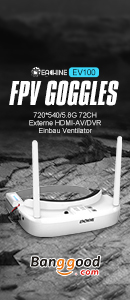ANA ist ein analog Input Auszug aus der Anleitung ich hoffe dein englisch Verständnis ist besser als meins

The pads marked ‘PWM’ may be used to blank the OSD display during flight. Two connection possibilities exist: 1) Take a 3-pin 0.1” header, trim the pins a little, and solder them into the three holes. 2) Take a standard 3-wire servo cable, and solder the three wires to the three PWM pads. In both cases, the left-most PWM pin is the PWM signal (orange, white, or yellow in the servo cable), and the right-most is ground (black or brown in the servo cable). Note that when the OSD display is blanked, any alarm will cause the display to return. A good example of this is a low-voltage alarm, this will un-blank the display, and warn the pilot to land quickly. Rx RSSI Display The pins marked ‘ANA’ are an analog input, which may be used to show the receiver signal strength. Note that EzOSD Firmware rev. 0.99 or later is required to take advantage of this feature. In order to use the RSSI feature you’ll first need to find the RSSI voltage output pin inside your RC receiver, which means opening up your RC receiver. Take notion that doing so will void its warranty, so don’t attempt this unless you’re confident you will be able to successfully put it back together again. Most modern receivers use surface mount technology which gets smaller with each revision. This makes soldering onto the RSSI pin very difficult, and is really not recommended unless you are quite skilled in the art of soldering. Most receivers use the same chipset for the RF frontend and hence use a similar RSSI implementation. A popular IC used in the RF frontend of RC receivers is the Toshiba TA31136, this is commonly used by RC receivers from Futaba for example. Pictured below is the Futaba R168DP PCM receiver with circled in blue the RSSI output pin. Simply soldering a piece of wire to this pin and a nearby ground connection (for example the ground of the strip of servo output pins) and routing these wires to the sensorboard of the OSD will be sufficient. However care should be taken that this wire is kept as short as possible and routed clear of ‘noisy’ wires, such as those connected to the battery, ESC and motor.


